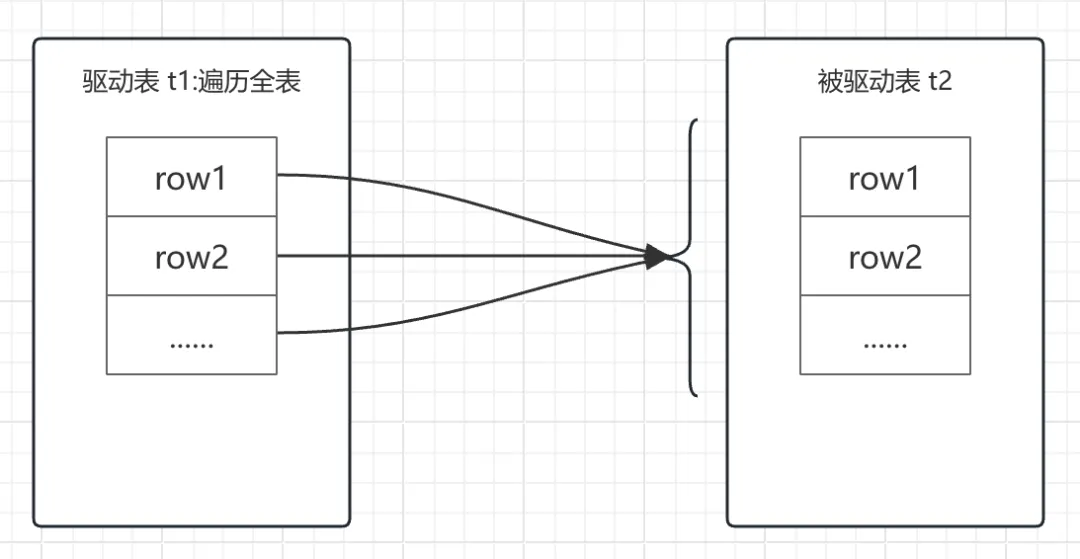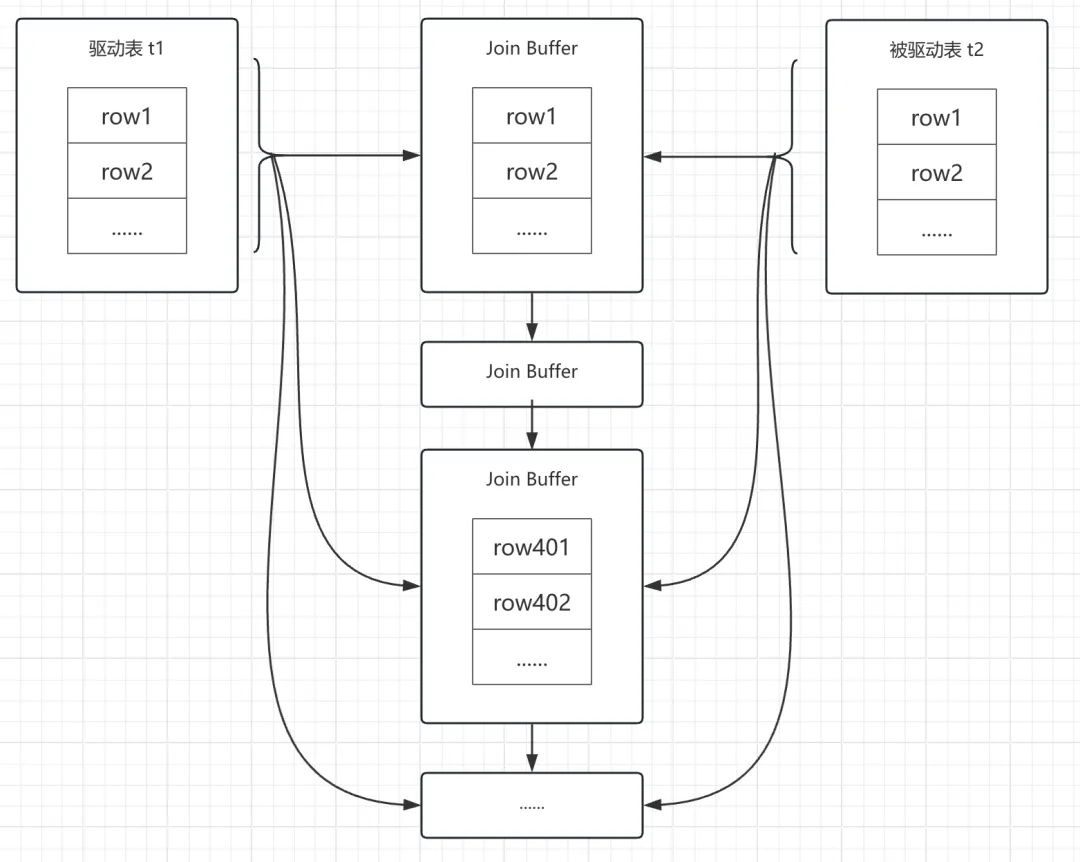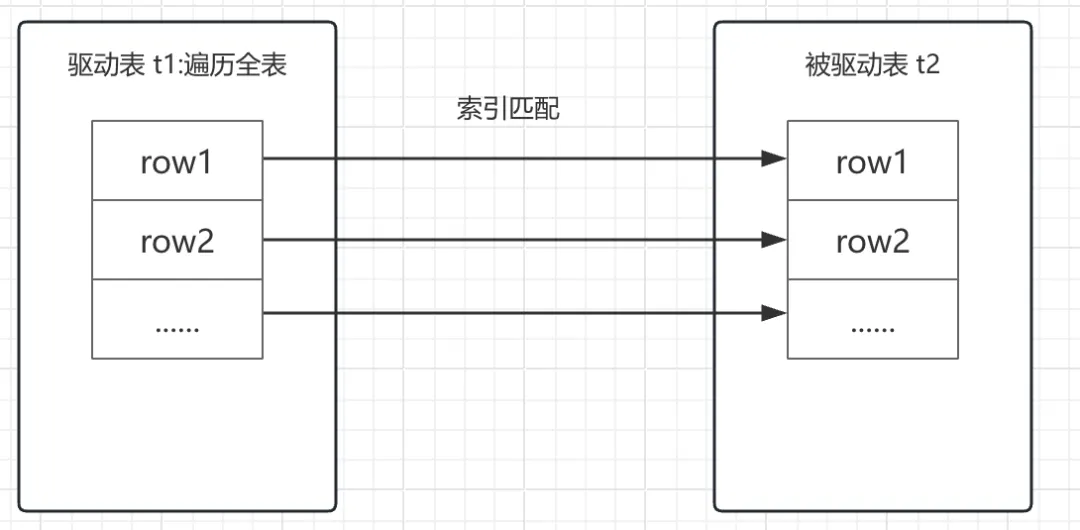從MySQL JOIN 算法角度看如何優化SQL
一、前言
在做MySQL的SQL優化時,如果只涉及到單表查詢,那么大部分慢SQL都只需從索引上入手優化即可,通過添加合適的索引來消除全表掃描或者排序操作,執行效果,大概率能實現質的飛躍。
然而,在實際生產中,除了單表查詢,更多的是多個表的聯合查詢,這樣的查詢通常是慢SQL的重災區,查詢速度慢,且使用服務器資源較多,如果能將這類SQL優化掉,那必將大大減輕數據庫服務器壓力。現在,咱就通過多表關聯內部數據操作的角度,看看如何進行SQL優化。
二、準備工作
現在線上環境大部分使用的都是MySQL 5.7.x版本,那咱就以5.7版本為主,適當延伸MySQL 8.0版本為輔進行講解測試。
創建測試表:
# 創建兩個表結構一模一樣的表:t1、t2
create table t1(
id int not null auto_increment,
a int,
b int,
c int,
primary key(id),
key idx_a(a)
);
create table t2 like t1;構造測試數據:
# 創建2個存儲過程用于構造測試數據
# 構造t1表數據的存儲過程,數據為3的整除數,1000條
delimiter //
create procedure t1_proc()
begin
declare i int default 1;
while (i<=3000) do
if (i%3) = 0 then
insert into t1(a,b,c) values(i, i, i);
end if;
set i=i+1;
end while;
end //
delimiter ;
# 構造t2表數據的存儲過程,數據為2的整除數,100000條
delimiter //
create procedure t2_proc()
begin
declare i int default 1;
while (i<=200000) do
if (i%2) = 0 then
insert into t2(a,b,c) values(i, i, i);
end if;
set i=i+1;
end while;
end //
delimiter ;
# 調用存儲過程,生成測試數據
call t1_proc();
call t2_proc();
# 刪除存儲過程
drop procedure t1_proc;
drop procedure t2_proc;數據樣例:
[5.7.37-log localhost:mysql.sock]>select * from t1 limit 5;
+----+------+------+------+
| id | a | b | c |
+----+------+------+------+
| 1 | 3 | 3 | 3 |
| 2 | 6 | 6 | 6 |
| 3 | 9 | 9 | 9 |
| 4 | 12 | 12 | 12 |
| 5 | 15 | 15 | 15 |
+----+------+------+------+
5 rows in set (0.00 sec)
[5.7.37-log localhost:mysql.sock]>select * from t2 limit 5;
+----+------+------+------+
| id | a | b | c |
+----+------+------+------+
| 1 | 2 | 2 | 2 |
| 2 | 4 | 4 | 4 |
| 3 | 6 | 6 | 6 |
| 4 | 8 | 8 | 8 |
| 5 | 10 | 10 | 10 |
+----+------+------+------+
5 rows in set (0.00 sec)三、MySQL JOIN算法
MySQL對兩表關聯,支持多種Join算法,咱就以下面這個SQL為例,深入探討一下。
測試SQL:
select * from t1 join t2 on t1.b=t2.b;1、Simple Nested-Loop Join
設想一下,如果兩表關聯,在沒有任何干預的情況下,他像不像下面這個偽代碼的嵌套循環:
for row_1 in t1: # 循環1000次
for row_2 in t2: # 對應每個外層循環10w次
if row_1.b == row_2.b:
do something從上面的偽代碼中,我們可以看到,其就是簡單粗暴的嵌套循環,我們將其稱為 Simple Nested-Loop Join。回到數據庫層面,在測試SQL兩個表關聯的過程中,t1表中的每一行數據,都會觸發掃描一次t2表的數據,然后進行數據匹配。總的來講就是,因為t1表有1000行數據,所以t2表會被掃描1000次,并進行1000 * 10w = 1億次數據比較。
 圖片
圖片
很顯然,如果使用這種方式,當 t2 表足夠大時,反復掃描數據的過程中,磁盤必然會被拉爆,服務器性能會急劇下降。像MySQL這樣優秀的產品,必然會想方設法的避免這種情況的發生。
2、Block Nested-Loop Join
緊接上面所說,既然 Simple Nested-Loop Join最大的弊端是被驅動表被反復掃描,那是不是可以從這方面入手,減少被驅動表的掃描次數,以達到優化目的。咱繼續往下看,看他是怎么實現的。
一般情況下,兩表關聯,MySQL都會將結果集小(指根據條件過濾后)的表做驅動表,結果集大的表當被驅動表,那是不是可以嘗試一下,把驅動表的結果集放到內存中(Join Buffer),然后一次性掃描被驅動表的所有數據,反過來與Join Buffer中的驅動表結果集進行比較。這方式,驅動表和被驅動表都只掃描一次,但在內存中進行數據比較的次數依然為 10w * 1000 = 1億次。很顯然,這方式,相對于Simple Nested-Loop Join而言,優勢非常明顯,MySQL管這個叫Block Nested-Loop Join。
 圖片
圖片
聰明的你,是不是在想:如果驅動表t1的結果集,無法一次性全部存放到Join Buffer內存中時,怎么辦?
Join Buffer 的大小由參數 join_buffer_size 控制,默認為256K。在使用Join Buffer時,如果無法一次性存放所有結果集,他會分多次進行,比如:
1)讀取驅動表t1的數據,存放到Join Buffer中,假設,存放400條后,Join Buffer滿了,停止讀取
2)讀取被驅動表t2的數據,每一行數據都與Join Buffer中的數據進行比較,并返回符合條件的結果集
3)清空Join Buffer
4)繼續讀取驅動表t1的數據,將401-800的數據存放到Join Buffer,直到存滿
5)...... 繼續重復相似的動作,直到所有數據都比對完
 圖片
圖片
在上述假設情況下,因Join Buffer大小限制的原因,被驅動表 t2 被掃描了3次。總的來講,雖然不算完美,但顯然比使用Simple Nested-Loop Join的方式容易接受多了。也就是說,MySQL在經過對表鏈接進行優化后,就不會再出現使用Simple Nested-Loop Join的情況了。
執行計劃:
[5.7.37-log localhost:mysql.sock]>explain select * from t1 join t2 on t1.b=t2.b\G
*************************** 1. row ***************************
id: 1
select_type: SIMPLE
table: t1
partitions: NULL
type: ALL
possible_keys: NULL
key: NULL
key_len: NULL
ref: NULL
rows: 1000
filtered: 100.00
Extra: NULL
*************************** 2. row ***************************
id: 1
select_type: SIMPLE
table: t2
partitions: NULL
type: ALL
possible_keys: NULL
key: NULL
key_len: NULL
ref: NULL
rows: 100256
filtered: 10.00
Extra: Using where; Using join buffer (Block Nested Loop)
2 rows in set, 1 warning (0.00 sec)3、Hash Join
雖然經過MySQL優化后的 Block Nested-Loop Join 算是改進了不少,但是,對各位程序員大拿而言,必然是一眼就看出了還有改進的余地。
Block Nested-Loop Join 在將驅動表結果集存放到Join Buffer后,被驅動表的數據與其比對時,被驅動表的每一行數據,都要與Join Buffer中所有數據進行比對,才能得出匹配的結果。這像不像對MySQL實體表進行條件查詢時,進行了全表掃描的操作一樣。這情況,如果給條件列加個索引,查詢速度是不是要瞬間起飛。
想法很好,但很不幸,MySQL 5.7.x 版本不支持;但也很慶幸,MySQL 8.0版本實現了,他會根據驅動表結果集,將關聯列映射為哈希值后鍵創建哈希表,被驅動表的數據在與哈希表進行比較時,就大大降低了比較次數,這也達到了優化的目的,我們管其叫Hash Join。
 圖片
圖片
咱看看其執行計劃:
[8.0.27 127.0.0.1:3380]>explain select * from t1 join t2 on t1.b=t2.b\G
*************************** 1. row ***************************
id: 1
select_type: SIMPLE
table: t1
partitions: NULL
type: ALL
possible_keys: NULL
key: NULL
key_len: NULL
ref: NULL
rows: 1000
filtered: 100.00
Extra: NULL
*************************** 2. row ***************************
id: 1
select_type: SIMPLE
table: t2
partitions: NULL
type: ALL
possible_keys: NULL
key: NULL
key_len: NULL
ref: NULL
rows: 100400
filtered: 10.00
Extra: Using where; Using join buffer (hash join)
2 rows in set, 1 warning (0.00 sec)咱再來對比一下Block Nested-Loop Join和Hash Join的執行速度:
[5.7.37-log localhost:mysql.sock]>select * from t1 join t2 on t1.b=t2.b;
......
+------+------+------+------+------+------+
500 rows in set (4.90 sec)
[8.0.27 127.0.0.1:3380]>select * from t1 join t2 on t1.b=t2.b;
......
+------+------+------+------+------+------+
500 rows in set (0.02 sec)從執行邏輯和執行結果上,都印證了Hash Join必然會比Block Nested-Loop Join要好。所以,在MySQL 8.0版本,Block Nested-Loop Join將不復存在,所有原先使用其算法的表關聯SQL,最終都會被優化成選擇Hash Join進行表關聯。
4、Index Nested-Loop Join
前面提到的 Block Nested-Loop Join 和 Hash Join,都是MySQL自己內部實現的優化,如果沒有其他更好的算法,那么基于這兩種算法基礎上的表關聯慢SQL,人為干預改進的可能性,是不是就微無其微了。
我們仔細分析一下前面這兩種算法的特點,Block Nested-Loop Join 的改進是降低了表掃描次數, Hash Join的改進是降低了數據對比的次數,但他兩,依然有一個致命的共同點,如果被驅動表足夠大(大表)時,比如有N億數據量,那么,哪怕掃描一次被驅動表,也會引起數據庫性能急劇下降。
知道了問題在哪,自然就有了優化的方向。設想一下,如果被驅動表的關聯列,像Hash Join中的哈希表一樣,存在索引,會是個什么情況呢?
 圖片
圖片
驅動表中的每一行記錄,都可以通過被驅動表的索引列,進行索引查找(與關聯列有關,可以是主鍵,也可以是二級索引),這瞬間就解決了被驅動表被掃描的問題。其本質,和單表查詢中,通過建立合適索引的方式進行優化,是不是很相似。哪怕驅動表再大,如果索引列每個鍵值對應的數據量不大,那么索引查找速度依然可以快到起飛,這算法就叫 Index Nested-Loop Join。
先前咱兩個測試表中,a列和b列數據是一樣的,a列有索引,b列無索引,所以,咱將測試SQL變通一下
select * from t1 join t2 on t1.b=t2.b;
# 替換為
select * from t1 join t2 on t1.b=t2.a;執行計劃:
[5.7.37-log localhost:mysql.sock]>explain select * from t1 join t2 on t1.b=t2.a\G
*************************** 1. row ***************************
id: 1
select_type: SIMPLE
table: t1
partitions: NULL
type: ALL
possible_keys: NULL
key: NULL
key_len: NULL
ref: NULL
rows: 1000
filtered: 100.00
Extra: Using where
*************************** 2. row ***************************
id: 1
select_type: SIMPLE
table: t2
partitions: NULL
type: ref
possible_keys: idx_a
key: idx_a
key_len: 5
ref: db1.t1.b
rows: 1
filtered: 100.00
Extra: NULL
2 rows in set, 1 warning (0.00 sec)執行速度:
[5.7.37-log localhost:mysql.sock]>select * from t1 join t2 on t1.b=t2.a;
......
+------+------+------+------+------+------+
500 rows in set (0.01 sec)你是不是在疑惑,看這執行速度,和Hash Join差別也不大,那是因為咱的被驅動表t2數據量太少,隨著測試數據量的增大,差距會越來越明顯。
四、優化思路
前面的測試SQL,相對來講,簡化的有點過于簡單了,實際應用中,必然會有一大堆查詢條件跟在其后,那這一堆查詢條件,在進行SQL優化時,會不會對你造成干擾呢?
1、初始SQL
測試SQL做個變化,讓其他稍微貼近實際情況:
select *
from t1 join t2 on t1.b = t2.b
where
t1.c in (6, 12, 18, 24, 30)
and t2.c in (6, 12, 18, 24, 30);執行計劃:
[5.7.37-log localhost:mysql.sock]>explain select *
-> from t1 join t2 on t1.b = t2.b
-> where
-> t1.c in (6, 12, 18, 24, 30)
-> and t2.c in (6, 12, 18, 24, 30)\G
*************************** 1. row ***************************
id: 1
select_type: SIMPLE
table: t1
partitions: NULL
type: ALL
possible_keys: NULL
key: NULL
key_len: NULL
ref: NULL
rows: 1000
filtered: 50.00
Extra: Using where
*************************** 2. row ***************************
id: 1
select_type: SIMPLE
table: t2
partitions: NULL
type: ALL
possible_keys: NULL
key: NULL
key_len: NULL
ref: NULL
rows: 100345
filtered: 5.00
Extra: Using where; Using join buffer (Block Nested Loop)
2 rows in set, 1 warning (0.00 sec)從上面的執行計劃可以看到,t1表較小為驅動表,t2表較大為被驅動表。咱一步一步分析,暫時剔除t2表,先看t1表是否有優化的空間,其現在是全表掃描,并通過t1.c列進行數據過濾。單表查詢,如果查詢條件列有索引,必然會加快查詢速度對吧。
2、SQL優化1
t1表中,a、b、c列數據是一樣的,a列有索引,所以咱不額外創建索引了,直接使用a列替代c列,重寫測試SQL:
select *
from t1 join t2 on t1.b = t2.b
where
t1.a in (6, 12, 18, 24, 30)
and t2.c in (6, 12, 18, 24, 30);查看新的執行計劃:
[5.7.37-log localhost:mysql.sock]>explain select *
-> from t1 join t2 on t1.b = t2.b
-> where
-> t1.a in (6, 12, 18, 24, 30)
-> and t2.c in (6, 12, 18, 24, 30)\G
*************************** 1. row ***************************
id: 1
select_type: SIMPLE
table: t1
partitions: NULL
type: range
possible_keys: idx_a
key: idx_a
key_len: 5
ref: NULL
rows: 5
filtered: 100.00
Extra: Using index condition
*************************** 2. row ***************************
id: 1
select_type: SIMPLE
table: t2
partitions: NULL
type: ALL
possible_keys: NULL
key: NULL
key_len: NULL
ref: NULL
rows: 100345
filtered: 5.00
Extra: Using where; Using join buffer (Block Nested Loop)
2 rows in set, 1 warning (0.00 sec)t1表從原先的全表掃描,變成了索引查找,預估讀取的數據行,也從原來的1000行變成了5行,優化效果明顯。此時,再看看t2表,因為關聯列t2.b沒有索引,查詢列t2.c也沒有索引,所以t2表是掃描一次后,通過Block Nested-Loop Join算法與Join Buffer中的數據進行匹配。
在前面講解Index Nested-Loop Join時,咱知道,如果關聯列 t2.b 有索引,就會使用Index Nested-Loop Join算法進行數據匹配,那,如果關聯列沒索引,但是查詢過濾列 t2.c 有索引,會是怎樣的?
3、SQL優化2
同樣的,咱用 t2.a 列替代 t2.c 列,重寫測試SQL:
select *
from t1 join t2 on t1.b = t2.b
where
t1.a in (6, 12, 18, 24, 30)
and t2.a in (6, 12, 18, 24, 30);執行計劃:
[5.7.37-log localhost:mysql.sock]>explain select *
-> from t1 join t2 on t1.b = t2.b
-> where
-> t1.a in (6, 12, 18, 24, 30)
-> and t2.a in (6, 12, 18, 24, 30)\G
*************************** 1. row ***************************
id: 1
select_type: SIMPLE
table: t1
partitions: NULL
type: range
possible_keys: idx_a
key: idx_a
key_len: 5
ref: NULL
rows: 5
filtered: 100.00
Extra: Using index condition
*************************** 2. row ***************************
id: 1
select_type: SIMPLE
table: t2
partitions: NULL
type: range
possible_keys: idx_a
key: idx_a
key_len: 5
ref: NULL
rows: 5
filtered: 10.00
Extra: Using index condition; Using where; Using join buffer (Block Nested Loop)
2 rows in set, 1 warning (0.00 sec)與前面的執行計劃對比發現,其依然是使用Block Nested-Loop Join算法,只不過原先t2表,從全表掃描,變成了通過 t2.a 列索引,一次性查找出全部數據后,再與Join Buffer中t1表的結果集進行匹配,如果 t2.a 列根據查詢條件過濾出來的數據,足夠少,這也不失為一個較好的優化思路。
4、SQL優化3
當然了,如果關聯列有索引,查詢列沒索引,你已經知道了是使用Index Nested-Loop Join算法,繼續重寫測試SQL:
select *
from t1 join t2 on t1.b = t2.a
where
t1.a in (6, 12, 18, 24, 30)
and t2.c in (6, 12, 18, 24, 30);執行計劃:
[5.7.37-log localhost:mysql.sock]>explain select *
-> from t1 join t2 on t1.b = t2.a
-> where
-> t1.a in (6, 12, 18, 24, 30)
-> and t2.c in (6, 12, 18, 24, 30)\G
*************************** 1. row ***************************
id: 1
select_type: SIMPLE
table: t1
partitions: NULL
type: range
possible_keys: idx_a
key: idx_a
key_len: 5
ref: NULL
rows: 5
filtered: 100.00
Extra: Using index condition; Using where
*************************** 2. row ***************************
id: 1
select_type: SIMPLE
table: t2
partitions: NULL
type: ref
possible_keys: idx_a
key: idx_a
key_len: 5
ref: db1.t1.b
rows: 1
filtered: 50.00
Extra: Using where
2 rows in set, 1 warning (0.00 sec)被驅動表關聯列有索引,查詢列無索引,使用Index Nested-Loop Join算法。
5、疑問
如果t2表中,關聯列和查詢列,都有索引,他會怎么選?為了更好的比較,咱給 t2.c 列創建一個索引,并對 t2.a 列的數據進行適當的調整。
# 添加c列索引
alter table t2 add index idx_c(c);
# 調整t2表a列數據,a列查詢條件中的值,每個值對應的數據量為4000
update t2 set a=a%50;
# 消除表碎片,避免被其干擾
alter table t2 engine=innodb;
# 驅動表傳過來的鍵值,每個鍵值對應的數據為4000行
[5.7.37-log localhost:mysql.sock]>select a,count(a) cnt
-> from t2
-> where a in (6, 12, 18, 24, 30)
-> group by a;
+------+------+
| a | cnt |
+------+------+
| 6 | 4000 |
| 12 | 4000 |
| 18 | 4000 |
| 24 | 4000 |
| 30 | 4000 |
+------+------+
5 rows in set (0.01 sec)
# 總共符合條件的數據,5行
[5.7.37-log localhost:mysql.sock]>select * from t2 where c in (6, 12, 18, 24, 30);
+----+------+------+------+
| id | a | b | c |
+----+------+------+------+
| 3 | 6 | 6 | 6 |
| 6 | 12 | 12 | 12 |
| 9 | 18 | 18 | 18 |
| 12 | 24 | 24 | 24 |
| 15 | 30 | 30 | 30 |
+----+------+------+------+
5 rows in set (0.01 sec)重寫測試SQL:
select *
from t1 join t2 on t1.b = t2.a
where
t1.a in (6, 12, 18, 24, 30)
and t2.c in (6, 12, 18, 24, 30);執行計劃:
[5.7.37-log localhost:mysql.sock]>explain select *
-> from t1 join t2 on t1.b = t2.a
-> where
-> t1.a in (6, 12, 18, 24, 30)
-> and t2.c in (6, 12, 18, 24, 30)\G
*************************** 1. row ***************************
id: 1
select_type: SIMPLE
table: t1
partitions: NULL
type: range
possible_keys: idx_a
key: idx_a
key_len: 5
ref: NULL
rows: 5
filtered: 100.00
Extra: Using index condition
*************************** 2. row ***************************
id: 1
select_type: SIMPLE
table: t2
partitions: NULL
type: range
possible_keys: idx_a,idx_c
key: idx_c
key_len: 5
ref: NULL
rows: 5
filtered: 4.55
Extra: Using index condition; Using where; Using join buffer (Block Nested Loop)
2 rows in set, 1 warning (0.00 sec)由此可見,Block Nested-Loop Join (Hash Join)與 Index Nested-Loop Join 對比,并沒有哪一種算法更優一說,只要其整體成本比另一種低,那他就是最合適的。當然了,前面所有例子,都是只有2個表關聯,對于3表及以上的關聯SQL而言,如果你把前2個表的關聯結果,當成一個新的驅動表看待,那么所有后面的表關聯,是不是都只需分析兩表關聯的情況即可。
五、最后
至此,對于想學習SQL優化的你,功力是不是又有長進了。如果你還有其他疑問,可以寫在評論區,咱后面再繼續探討。






























